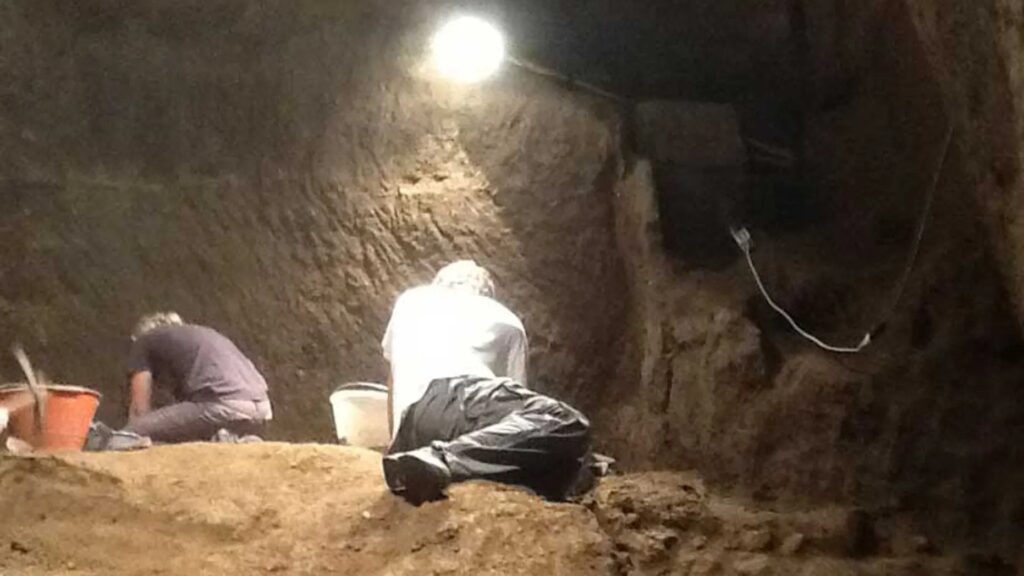Ancient, underground Etruscan pyramids spotted in Italy
The first-ever Etruscan pyramids have been located underneath a wine cellar in the city of Orvieto in central Italy, according to a team of U.S. and Italian archaeologists. Carved into the rock of the tufa plateau — a sedimentary area that is a result of volcanic activity — on which the city stands, the subterranean structures were largely filled. Only the top-most modern layer was visible.
“Within this upper section, which had been modified in modern times and was used as a wine cellar, we noticed a series of ancient stairs carved into the wall. They were clearly of Etruscan construction,” David B. George of the Department of Classics at Saint Anselm, told Discovery News.
As they started digging, George and co-director of the excavation Claudio Bizzarri of the Parco Archeologico Ambientale dell’Orvietano noted that the cave’s walls were tapered up in a pyramidal fashion. Intriguingly, a series of tunnels, again of Etruscan construction, ran underneath the wine cellar hinting at the possibility of deeper undiscovered structures below.

After going through a mid-20th century floor, George and Bizzarri reached a medieval floor. Immediately beneath this floor, they found a layer of fill that contained various artefacts such as Attic red-figure pottery from the middle of the 5th Century B.C., 6th and 5th century B.C. Etruscan pottery with inscriptions as well as various objects that dated to before 1000 B.C.
Digging through this layer, the archaeologists found 5 feet of gray sterile fill, which was intentionally deposited from a hole in the top of the structure.
“Below that material there was a brown layer that we are currently excavating. Intriguingly, the stone-carved stairs run down the wall as we continue digging. We still don’t know where they are going to take us,” Bizzarri told Discovery News.
The material from the deepest level reached so far (the archaeologists have pushed down about 10 feet) dates to around the middle of the fifth century B.C.
“At this level we found a tunnel running to another pyramidal structure and dating from before the 5th century B.C. which adds to the mystery,” George said.
Indeed, the Etruscans have long been considered one of antiquity’s greatest enigmas.
A fun-loving and eclectic people who among other things taught the French how to make wine, the Romans how to build roads, and introduced the art of writing to Europe, the Etruscans began to flourish in Etruria (an area in central Italy area that covered now are Tuscany, Latium, Emilia-Romagna and Umbria) around 900 B.C., and then dominated much of the country for five centuries.
Known for their art, agriculture, fine metalworking and commerce, they started to decline during the fifth century B.C., as the Romans grew in power. By 300-100 B.C., they eventually became absorbed into the Roman empire.
Their puzzling, non-Indo-European language was virtually extinguished and they left no literature to document their society. Indeed, much of what we know about them comes from their cemeteries: only the richly decorated tombs they left behind have provided clues to fully reconstruct their history.
The subterranean pyramids in Orvieto could offer a unique insight into this civilization as the structures appear to be unique.
“The caves have indeed a shape unknown elsewhere in Etruria,” Larissa Bonfante, professor emerita of classics at New York University and a leading expert on the ancient Etruscans, told Discovery News.
According to Bizzarri, there are at least five Etruscan pyramids under the city. Three of these structures have yet to be excavated.
“Clearly, they are not quarries or cisterns. I would say that there is nothing like these structures on record anywhere in Italy,” Bizzarri said.
According to George, the underground pyramids could represent some sort of a religious structure or a tomb. In both cases, it would be a discovery without precedent.
“Most likely, the answer waits at the bottom. The problem is we don’t really know how much we have to dig to get down there,” Bizzarri said.





